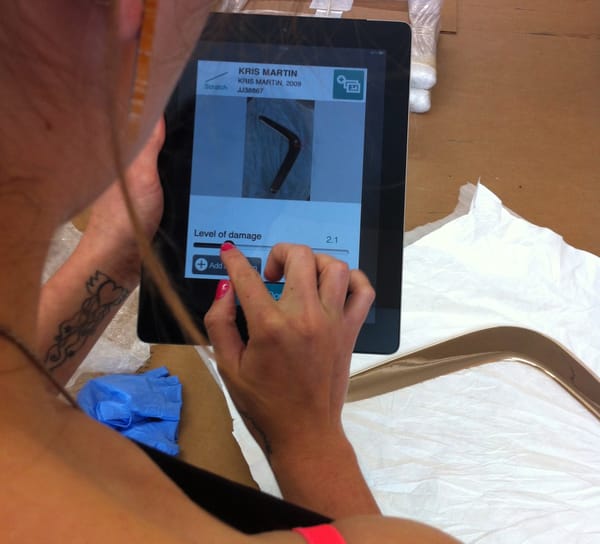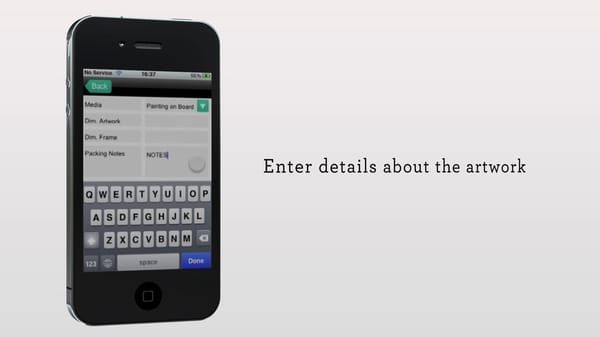Technology helps art conservators
Introducing a product that will revolutionise the condition checking process

By Senior Conservator Peggy Van Witt
© 2010 Peggy Van Witt. All Rights Reserved.
From paintings to murals, from pottery to sculpture, each form of art requires a specific method of conservation. The various methods of art conservation and art repair are highly specialized. Conservation artists spend years in school and most carry master's degrees in their field.
Specialties in art conservation include ceramics, furniture, sculpture, bronzes, and oil paintings, which also can be broken down into era specializations, to name a few. With each specialization come tricks and tools of the trade. This article will address the most prevalent forms of conservation applied to fine art paintings.
When many people hear the word "art" they envision a painting. This expression of creativity has been practiced by humans since we began to paint on the walls of caves thousands of years ago. And much like the art-form, the artwork too, is quite old - much of it in need of repair, restoration and thorough conservation. There are many reasons why a particular painting may need to be conserved. It may be dirty, cracked, or torn. The varnish may be darkened or yellowed. Whatever the reason may be, there are many different methods used in conserving paintings.
If the painting is on paper, it's most likely painted with water based medium, not oil. Paper will rot when it is painted with oil paint. A Paper Conservator can treat works of art on paper.
Art on paper such as this is extremely fragile and apt to tearing or deteriorating during the actual conservation. Often, conservation of this nature does more harm than good. If the painting is indeed oil and is applied to a canvas or wood backing, conservation efforts are often very successful.
 The actual technical process of the painting's conservation involves several standard steps. The first step is chemical in nature. Pre 1940, most oil paintings were covered in a varnish to protect the paint and to bring a desired sheen to the painting. Over time, this varnish can yellow or crack, especially if the painting has been exposed to a great deal of natural light. If the varnished is yellowed or cracked, it must be removed during conservation. To remove the varnish, a solvent is carefully applied directly to the painting with a cotton swab until the all of the varnish is removed but none of the paint. This process can be quite time consuming. Some oil paintings have a rich texture, and removing varnish from the nooks and crevasses of the painting can be difficult.
The actual technical process of the painting's conservation involves several standard steps. The first step is chemical in nature. Pre 1940, most oil paintings were covered in a varnish to protect the paint and to bring a desired sheen to the painting. Over time, this varnish can yellow or crack, especially if the painting has been exposed to a great deal of natural light. If the varnished is yellowed or cracked, it must be removed during conservation. To remove the varnish, a solvent is carefully applied directly to the painting with a cotton swab until the all of the varnish is removed but none of the paint. This process can be quite time consuming. Some oil paintings have a rich texture, and removing varnish from the nooks and crevasses of the painting can be difficult.
If the layer of paint beneath the varnish is also damaged, it too must be restored during the conservation process. To restore the damaged paint, a professional art conservator will remove the upper layer of varnish first, and then apply a new layer of varnish before retouching with any new paint. This process is called 'reversible' restoration and is a skill practiced and revered among conservation professionals. In the event of the repainting being incorrect, the process can be reversed back to the fresh layer of varnish and done as many times as needed until the repainting is correct.
Paintings produced after 1940 will most likely not be coated with a layer of varnish. In the instance that the painting does not need to have varnished removed, the second step in conservation is to remove the build-up of smoke, dust and grime. Art conservators employ two different methods in cleaning up the residue that has built up on paintings over time.


The first method is to use a cocktail of solvents or detergents to meticulously clean the painting. Because the paint used is oil, they can withstand a careful application of a moist, but not wet swabbing. Proper detergent cleaning will be done only once. Cleaning the painting with solvents or detergents can do irreversible damage if done too aggressively. Conservators will often not attempt to conserve a painting if they know it has been cleaned more than twice, depending on the age and value of the painting.
The second method of removing smoke, dust and grime is to use a low intensity adhesive to pull the grime off the surface. This technique requires a great deal of skill and is avoided entirely with very old paintings whose paint could be plucked off the wood or canvas upon which it is painted. A newer technique uses compressed air to blow the particles of grime or soot off the painting. It has been quite effective to remove actual particle matter, but does very little to combat paint darkening, yellowing, or blotchiness. Whatever combination of conservation techniques are used, it is important to keep in mind that this process is done best when not rushed. Some paintings take several years to be completely restored and conserved.
Posted on Fri, November 19, 2010 by Peggy Van Witt,



Description
Condition checking made easy.Protect your artwork and cultural objects with an app that sets a new standard in professional condition reporting.
Faster
1. Articheck allows you to condition check in 1/2 the time or better. In a recent timed test it was up to 4 times faster.
Save Time and Money
2. This means you can save money in your freelance tech budget or perform at least twice as many condition checks with the same resources you currently have.
Savings with Freelance Technicians: 50-75% faster means that for each day spent condition reporting: 8 hours at an average $18/hour for a freelance technician = $144/Day
could now take as little as 2-4 hours, costing $36 -$72, giving you a savings of $72-$108 per day's condition checking, per technician
Easier
3. Articheck is easy to use, with prompts that help the condition checking process run more smoothly and become more standardised. Tools allow you to create a new record based on the last, so you don't have to re-type details like artist, exhibition, dimensions, frame type when working with a set. This helps reduce human error and streamline the process. A voice recording function will automatically convert your voice recording to text notes, allowing you to keep your eyes on the artwork.
Better
Highly professional PDF reports, complete with your logo and electronic signature, can be output with the push of a button. Impress your clients in a fraction of the time.